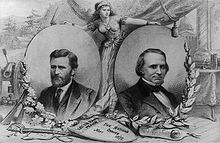Henry Wilson (Politiker, 1812)
Henry Wilson (* 16. Februar 1812 in Farmington, Strafford County, New Hampshire; † 22. November 1875 in Washington, D.C.; eigentlich Jeremiah Jones Colbath) war ein US-amerikanischer Politiker und von 1873 bis zu seinem Tode Vizepräsident der Vereinigten Staaten. Zuvor vertrat er seit 1855 den Bundesstaat Massachusetts im US-Senat.
Leben
Henry Wilson wurde als Jeremiah Jones Colbath in New Hampshire geboren und wurde von seinem Vater, als er zehn Jahre alt war, wegen Armut an den Farmer Henry Wilson zur Adoption abgegeben. Er ließ seinen Namen 1833 in Henry Wilson umändern.
Wilson zog 1833 nach Natick in Massachusetts, erlernte das Schuhmacherhandwerk und betrieb neben dem Handwerk politische und nationalökonomische Studien. 1840 trat er als Anhänger der Whigs öffentlich als Redner auf und war zwischen 1841 und 1852 Abgeordneter in beiden Kammern des Massachusetts General Court, wobei er 1848 die Free Soil Party mit gründete. 1848 bis 1851 betrieb er nebenbei als Redakteur seine eigenen Zeitung Boston Republican. 1855 trat er zur Know-Nothing Party über und wurde von einer Koalition dieser Partei mit der Free Soil Party und Gegnern der Sklaverei in der Demokratischen Partei als Senator von Massachusetts in den Kongress gewählt. Später schloss er sich den Republikanern an. Er war bis zum 3. März 1873 Senator, während dieser Zeit war er unter anderem Vorsitzender des Militärausschusses.
Im Amerikanischen Bürgerkrieg diente er 1861 kurze Zeit als Stabsoffizier unter General George McClellan. Im Jahr 1872 wurde Wilson als Running Mate von Präsidentschaftskandidat Ulysses S. Grant aufgestellt, nachdem Amtsinhaber Schuyler Colfax wegen einer Reihe von Skandalen nicht wieder nominiert wurde. Nach dem Wahlsieg von Grant wurde Wilson am 4. März 1873 als neuer Vizepräsident vereidigt. Nach seinem Amtsantritt übte er jedoch, für die damalige Zeit nicht unüblich, keinen nennenswerten Einfluss auf die Regierungspolitik aus. Er starb nach einem Schlaganfall am 22. November 1875 im Kapitol in Washington vor dem Ablauf seiner Amtszeit. Das Amt des Vizepräsidenten blieb bis 1877 vakant, da es gemäß der damaligen Rechtslage nur mittels Volkswahl im Turnus von vier Jahren besetzt werden konnte.
Werke
- History of antislavery measures (1864)
- History of the rise and fall of the slave-power in America. 3 Bde., unvollendet (1872–1876)
Literatur
- Nason: Life and public services of Henry Wilson. Boston 1881.
- Ernest A. McKay: Henry Wilson, Practical Radical. Portrait of a Politician. Kennikat, Port Washington 1971, ISBN 0-8046-9010-3.
- John L. Myers: Henry Wilson and the Era of Reconstruction. University Press of America, Lanham 2009, ISBN 0-7618-4742-1.
- Richard H. Abbott: Cobbler in Congress. Life of Henry Wilson, 1812-75. University Press of Kentucky, Lexington 1972, ISBN 0-8131-1249-4.
Weblinks
- Henry Wilson im Biographical Directory of the United States Congress (englisch)
- Henry Wilson in der Datenbank von Find a Grave (englisch)
- Henry Wilson im Miller Center of Public Affairs der University of Virginia (englisch)
| Personendaten | |
|---|---|
| NAME | Wilson, Henry |
| ALTERNATIVNAMEN | Colbath, Jeremiah Jones (wirklicher Name) |
| KURZBESCHREIBUNG | US-amerikanischer Politiker, Vizepräsident der Vereinigten Staaten |
| GEBURTSDATUM | 16. Februar 1812 |
| GEBURTSORT | Farmington, Strafford County, New Hampshire |
| STERBEDATUM | 22. November 1875 |
| STERBEORT | Washington, D.C. |
Auf dieser Seite verwendete Medien
Autor/Urheber:
Louis Dreka designed the actual seal, first used in 1885 per here. Vectorized from a version in stained glass.
The Seal of the United States Senate, the upper house of the United States Congress. See also the Seal of the United States House of Representatives.
Signature of H. Wilson.
Lithograph shows a campaign banner for the 1872 Republican national ticket. The armored figure of Liberty stands between portraits of presidential candidate Ulysses S. Grant and running mate Henry Wilson. Grant's portrait is adorned with oak leaves and Wilson's with olive or laurel branches. On the left are military paraphernalia associated with Grant--rifles, a cannon, and a sword. Beyond is a log cabin. On the right are a writing desk and the Constitution. In the distance is a view of the U.S. Capitol. Below, before the two portraits, is a shield inscribed "Let Us Have Peace. The Nation's Choice. Novr. 1872." "Let us have peace" were the closing words in Grant's May 29, 1868, letter accepting his first presidential nomination. The phrase became a Republican slogan for both the 1868 and 1872 elections.
Seal of the Vice President of the United States. The blazon is defined in Executive Order 11884 as:
The design is the same as the Seal of the President of the United States, except that there is no ring of stars, the clouds are gray (instead of proper), the stars are gray (instead of argent), the scroll is gray (instead of white), the arrows are gray (instead of proper), and the background colors and inscription (obviously) differ.The Coat of Arms of the Vice President of the United States shall be of the following design:
SHIELD: Paleways of thirteen pieces argent and gules, a chief azure; upon the breast of an American eagle displayed holding in his dexter talon an olive branch proper and in his sinister a bundle of thirteen arrows gray, and in his beak a gray scroll inscribed "E PLURIBUS UNUM" sable.
CREST: Behind and above the eagle a radiating glory or, on which appears an arc of thirteen cloud puffs gray, and a constellation of thirteen mullets gray.
The Seal of the Vice President of the United States shall consist of the Coat of Arms encircled by the words "Vice President of the United States."









